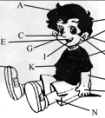按要求完成句子,每空一词。1.These are pencils.(改为单数句) ________ ________ ________ ________.2.He plays sports every day.(改为一般疑问句) ________ ________ ___-七年级英语
总之,系动词有无进行时态应随系动词的意义或其语境变化而变化。
我们在概述某一动词的进行时态时,不能笼统地说feel,smell无进行时,应指出其意义及其语用环境。
例如smell的用法可见一斑。
①smell作“嗅觉”的能力时,虽是实义动词,但指的是一种性质的存在状态不能用于进行时态,常与can, could, be able to连用。
The camels can smell the water a mile off.骆驼能嗅出一英里外有水。
②指“嗅、闻”的动作时,实义动词,可用于进行时态。
The girl is smelling the flower.这姑娘正在闻那朵花。
③smell指“含有……气味”,“发出……气味”等事物性质时,半系动词,无进行时态。
The dinner smells good.这饭菜闻起来真香。
2.系动词的时态与形容词的比较级连用的问题。
某些含有变化意义的动态系动词如get, become, grow, turn等的进行时态可与形容词的比较级连用,表示渐进过程,其意思是“越来越……”。例如:
He is growing taller and taller.他长得越来越高了。
Our life is getting better and better.我们的生活是越来越好了。
The things are getting worse.情况是越来越糟了。
3.所有半系动词的被动语态要分情况讨论。
英语中某动词在作系动词用时,无被动语态,而作实义动词用时,才有被动语态,二者不可混为一谈。例如:
不能说:
The apple is tasted good.
(因为taste此时是系动词,“尝起来”之意,指的是苹果的性质,无被动语态)
但我们可以说:
The apple is tasted by me.这苹果被我尝了一下。
(taste此时指“尝一尝”这一动作,有被动语态)
因此,在平时的英语教学和学习之 ,要有意注意半系动词在具体的语言环境中到底是系动词用法还是实义动词用法,要注意区分、识别。
4.瞬间动态系动词能否与时间段连用的问题
英语中某些表示瞬间意义的系动词不能与“for+时间段,since+时间点,how long until+时间,by + 时间,so far”等直接连用。例如:
①不能说:He has become a teacher for 2 years.
应改为:He has been a teacher for 2 years.
②不能说:He has turned writer since 3 years ago.
应改为:He has been a writer since 3 years ago.
或It is three years since he turned writer.
③不能说:He got angry until his child came back home.
应改为:He didn’t get angry until his child came back home.
5.系动词能接几种表语(从句)
系动词除了接adj.\n.\prep.短语,某些adv.以外,还可接以下几种表语形式:
①能接as if/as though表语从句的系动词有:look(看起来),smell(闻起来),sound(听起来),feel(觉得);appear(显得),seem(似乎)。例如:
It looks as if we are going to have snow.看样子天要下雪了。
He looked as if he had just stepped out of my book of fairy tales.
他看来好像刚从我的童话故事中走出来似的。
She seemed as if (though) she couldn’t understand why Laura was there.
看来她好像不能理解为什么劳拉呆在那儿。
It sounds to me as though there’s a tap running somewhere.
我好像听到某处水龙头流水的声音。
She felt as if her head were splitting.
她仿佛觉得她的头要裂开了。
The river appeared as if enveloped in smog.
那条河好像笼罩在烟雾之中。
It seems as if it were spring already.
好像已是春天了。
②可用于“It+系动词+that从句”结构的有:seem, appear, 不可用be, look。如:
It seemed that he had made some serious mistakes in his work.
好像他在工作中犯了严重错误。
It appeared that he was talking to himself.
好像他在自言自语。
③能用不定式作表语的系动词有:be, seem, get, look, appear, prove, grow.
Her job is to look after the children.
她的工作是照料孩子们。
He seems not to look after the children.
他好像不是她的父亲。
She looks to be a young girl of twenty year-old.
她看起来像是一个20岁的年轻姑娘。
He didn’t appear to dislike it.
看不出他憎恨此事。
My advice proved to be wrong.
我的建议证明是错误的。
He will grow to like this work gradually.
他会逐渐喜欢这个工作的。
④能与there连用的系动词有:be, appear, seem.
There appeared to be only one room.
那儿好像只有一个房间。
There seems(to be)no need to go.
似乎没有必要走。
6.能用两种否定形式的系动词有两个:seem, appear.
举例说明:
It doesn’t seem that we can get our money back.= It seems that we can’t get our money back.
He seems not to be her father.= He doesn’t seem to be her father.
The baby doesn’t appear to be awake.= The baby appears not to be awake.
7.后接作表语的过去分词可构成系表结构
能构成系表结构的系动词通常有两个:第一个是常见的be(is, am, was等);第二个是get,口语中常用。
当二者作系动词用时,它们均表示一种存在状态,而不表示被动动作;当二者作助动词用时,后接作谓语的过去分词构成被动语态。
Be + P.P常可以用get + P.P.来代替,但是并不是be系动词总是可以用get来代替。Get + P.P.系表结构常用于以下两种情况:
1)表示偶然的、突发性的、意想不到的被动动作的结果或状态。
Last night I got caught in the downpour.昨夜我被雨淋了(表示意想不到)
The new car got scratched.新车给刮坏了。(表突发性)
2)表示对自身所作的事。如get dressed, get lost等。
John got injured while playing football last Saturday.约翰上周星期六踢足球时受了伤。
They got married last month.他们上个月结婚了。
另外,要注意区分系表结构与被动语态结构的用法。
考点名称:并列连词
- 并列连词:
主要是用来表示并列关系、选择关系、因果推理关系等。也可用来连接平行的词,词组或分句。 并列连词表示关系及代表实例:
1.表示并列关系
表示并列关系的连词主要含有“和”、“补充”、“增加”等意思。用来表达并列关系的连词有如下几个:
and 和 both...and...二者都
either...or...或者...或者...
neither...nor...既不...也不...
as well as 也、连同
not only...but (also)... 不但...而且...
e.g.
I used to live in Paris and London.
我过去住在伦敦和巴黎。
Both Jane and Jim are interested in pop music.
詹妮和吉姆对流行音乐都很感兴趣。
She is not only kind but also honest.
她不但和蔼而且诚实。
Bob as well as his parents is going on holiday this summer.
鲍勃和他的父母今年夏天要去度假。
2.表示转折关系
常用来表示转折关系的并列连词有如下几个:
but 但是
yet 然而
still 仍然
while 然而
while 然而、偏偏
e.g.
The winter in Beijing is very cold while that of Kunming is warm.
北京的冬天很冷,然而昆明的冬天却很温暖。
I explained twice, still he counldn't understand.
我解释了两遍,然而他却还不懂。
3.表示选择关系
表示选择关系的并列连词:
or 或者
or else 否则
otherwise 否则
neither...nor... 既不...也不...
either...or... 或者...或者...
e.g.
Would you like leave or would you like to stay?
你是想走还是想留?
You can come either on Saturday or on Sunday.
你可以星期六来也可以星期天来。
Neither you nor I nor anyone else believes such things.
不管你我或者其他任何人都不会相信这件事。
4.表示因果推理关系
表示因果关系的并列连词主要有so,for,then,therefore 等。
e.g.
The air here is polluted, so the crops are dying.
这里的空气受到了污染,所以庄稼快死了。
The leaves of the trees are falling, for it's already autumn.
树叶在落下,因为秋天已经到来了。- 并列连词注意事项:
并列连词for引导的分句只能放在句尾,前面用逗号隔开,表示补充说明的微弱理由,只是为前面的内容提供判断的理由,有时译为并列的某种形式。
这与because不同,because引导的是一种明确的因果关系,解释原因,常可回答why的提问。 - 几个特殊并列连词用法:
一、表示并列关系的and,or,well,as,not only...but also... 等连词也有比较活跃的用法。
and 作为并列连词有多重含义,除了可以表示并列关系外,还可以表示顺承、目的、条件、反复等关系。
e.g:He went to market and bought some vegetables.(表示顺承,动作的先后发生)
他到市场买了一些蔬菜。
Come and help me out.(表示目的)
过来帮我一下。
Be careful and you'll make fewer mistakes.(表示条件)
如果仔细,你所犯的错就少。
二、or 与 either...or...
or表示为“否则”的话,前句一般是祈使句,后句用一般将来时。
在表示选择关系时or 与 either...or... 用法相同,但 either...or...更具强调性。
在多个对象进行选择时,可以用A or B or C... , either A or B or C... , neither A or B or C... 。
- 最新内容
- 相关内容
- 网友推荐
- 图文推荐
| [家长教育] 孩子为什么会和父母感情疏离? (2019-07-14) |
| [教师分享] 给远方姐姐的一封信 (2018-11-07) |
| [教师分享] 伸缩门 (2018-11-07) |
| [教师分享] 回家乡 (2018-11-07) |
| [教师分享] 是风味也是人间 (2018-11-07) |
| [教师分享] 一句格言的启示 (2018-11-07) |
| [教师分享] 无规矩不成方圆 (2018-11-07) |
| [教师分享] 第十届全国教育名家论坛有感(二) (2018-11-07) |
| [教师分享] 贪玩的小狗 (2018-11-07) |
| [教师分享] 未命名文章 (2018-11-07) |






